Understanding the Dubai Blue Line Metro's Impacts
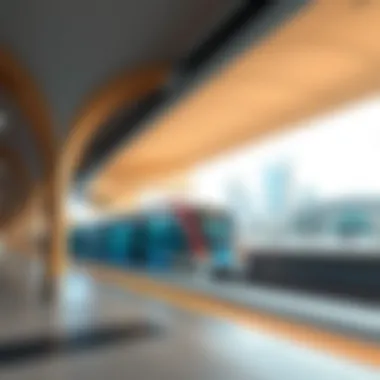
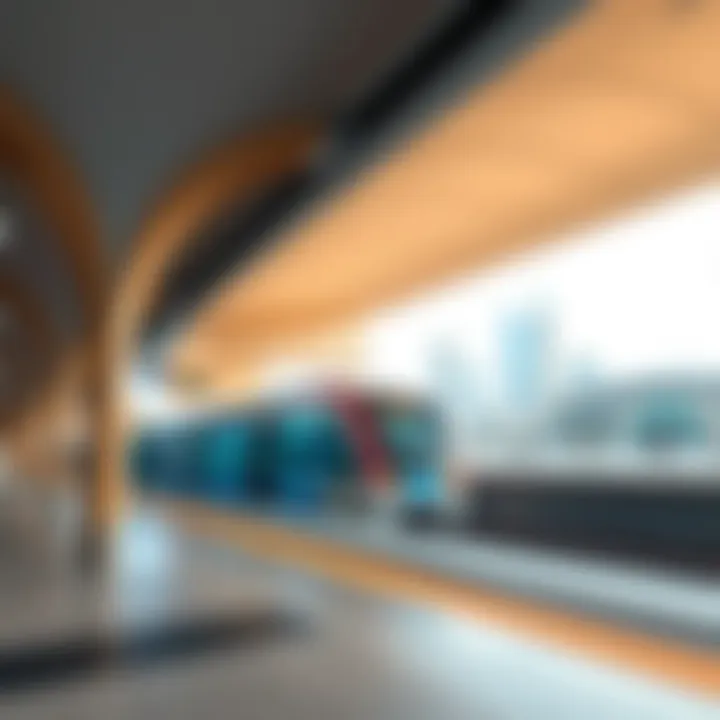
Intro
As Dubai continues its rapid ascent as a global city, transport infrastructures like the Blue Line Metro become crucial to enabling not just mobility but economic growth. This network presents not just a way for residents to navigate the metropolis, but also defines the urban landscape and shapes property values. Understanding the elements surrounding the Blue Line can bring significant insights to investors and homebuyers alike.
The Blue Line Metro, as part of Dubai's ongoing expansion of its public transportation system, is set to revolutionize how both residents and visitors interact with the city. With a well-thought-out design, operational efficiency, and integration with existing transport, it offers a comprehensive solution to urban mobility challenges. However, it is essential to discuss the complex implications this project bears—for the economy, real estate, and societal dynamics—it unfolds on a grand scale.
As we traverse the intricate discussions regarding market trends, property insights, and socio-economic impacts associated with the Blue Line Metro, the aim is to furnish industry stakeholders with both context and foresight. What emerges from our exploration is not just a transportation initiative but a transformative aspect of urban strategy, richly woven into Dubai’s narrative.
Market Trends
Current Market Analysis
The introduction of the Blue Line Metro represents a seismic shift in Dubai's public transport scenario. The project is expected to enhance real estate values within close proximity to its stations, with preliminary indicators already suggesting a rise in demand around upcoming metro stops. Areas like Business Bay and Dubai Marina exhibit rising interest from potential investors and homebuyers alike. The influx of commuters striving to reach these hubs is leading to a discernible uptick in rental and purchase prices in adjacent neighborhoods.
A recent analysis showed that properties within a 500-meter radius of metro stations command higher prices—sometimes by as much as 20% compared to similar units located further away. These trends suggest a clear relationship between accessibility and desirability in urban living.
Future Projections
Looking ahead, the implications of the Blue Line will likely ripple throughout Dubai's real estate market. Several experts predict that neighborhoods along the line will evolve to host more mixed-use developments that integrate residential, commercial, and recreational facilities. This shift can promote local economies while ensuring a vibrant lifestyle for residents.
A projected population increase, fueled by the metro's connectivity, suggests further demand for housing solutions. The ongoing investments in commercial areas close to the metro stops hint at a positive cycle, where improved accessibility breeds economic opportunities, ultimately fueling real estate prices further.
"In cities where mass transit expands, so does the demand for nearby property. Dubai's case is no exception—this Blue Line will create a nexus of modern life, transforming the urban fabric as we know it."
Property Insights
Neighborhood Comparisons
Not all neighborhoods will benefit alike from the Blue Line Metro expansion. Areas such as Bur Dubai and Deira historically show promising growth potential but may highlight different challenges compared to areas like Jumeirah Lakes Towers. Investors and analysts need to weigh these variances carefully. Generally, communities with robust amenities, schools, and recreational areas alongside metro accessibility are likely to retain high investment appeal.
Property Types Explained
When addressing property types affected by the Blue Line, it's crucial to differentiate among them:
- Apartments: Likely to see increased interest, particularly from young professionals.
- Commercial Spaces: These will likely flourish amid rising foot traffic, encouraging boutique shops and cafes.
- Mixed-Use Developments: As urban living becomes more integrated, these developments can draw varied demographics.
Prologue to the Dubai Blue Line Metro
The Dubai Blue Line Metro represents a significant milestone in the evolution of urban transport in an ever-expanding metropolis. This section sheds light on its importance, encapsulating the various dimensions that the Blue Line brings to the tapestry of Dubai’s public transit system. The study of this infrastructure not only highlights its technical prowess but also emphasizes its social, economic, and environmental ramifications.
Overview of Public Transportation in Dubai
Public transportation in Dubai has undergone transformative changes over the past decades. Once heavily reliant on private vehicles, the city has steadily embraced a more inclusive and sustainable approach to transport solutions. The introduction of the Dubai Metro, which includes the Blue Line, marks a fundamental shift towards efficient urban mobility.
Dubai's Fastrack ethos breeds a demand for speed and efficiency, and the metro is a testament to this ambition. The existing network, including the Red and Green lines, have laid the groundwork for further developments. The Dubai Roads and Transport Authority (RTA) continues to spearhead initiatives to integrate smart transport solutions, making commutes easier for residents and tourists alike.
In light of the rapid population growth, these transit solutions have become indispensable, connecting isolated areas and easing traffic congestion. The Blue Line Metro promises to intensify this integration and accessibility, creating a vivid link between various parts of the city. In a nutshell, the journey of public transportation in Dubai reflects an adaptive response to urban challenges, and the Blue Line is set to amplify this narrative.
The Significance of the Blue Line
The significance of the Blue Line cannot be overstated; it embodies the future of transportation in Dubai while simultaneously enhancing the quality of life for its denizens. First and foremost, it fundamentally alters the ways in which people navigate the city, reducing dependency on cars and lessening the environmental impact.
Another notable aspect is its potential to drive economic activity. With increased accessibility, businesses are likely to flourish near metro stations, fostering a vibrant ecosystem where commerce and convenience intersect. Additionally, the anticipated rise in property values along the Blue Line corridor suggests a positive outlook for investors and home buyers who wish to capitalize on the real estate dynamics generated by enhanced connectivity.
In an era where urban mobility is closely linked to economic resilience, the Blue Line serves as a critical strategic tool. It represents a commitment to sustainable growth, potentially alleviating traffic woes while paving the way for a more connected city where cultural exchange can thrive. Investors, home buyers, and property agents must keep a keen eye on how these developments unfold as the Blue Line begins to influence the Dubai landscape in meaningful ways.
"The advent of the Blue Line Metro will not just advance transport; it will shape the very essence of urban living in Dubai."
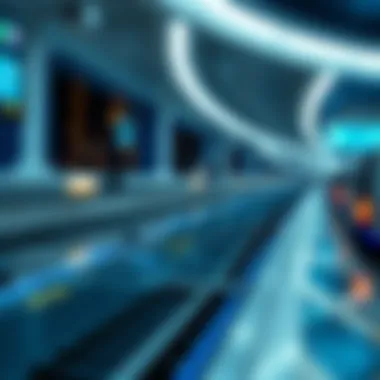
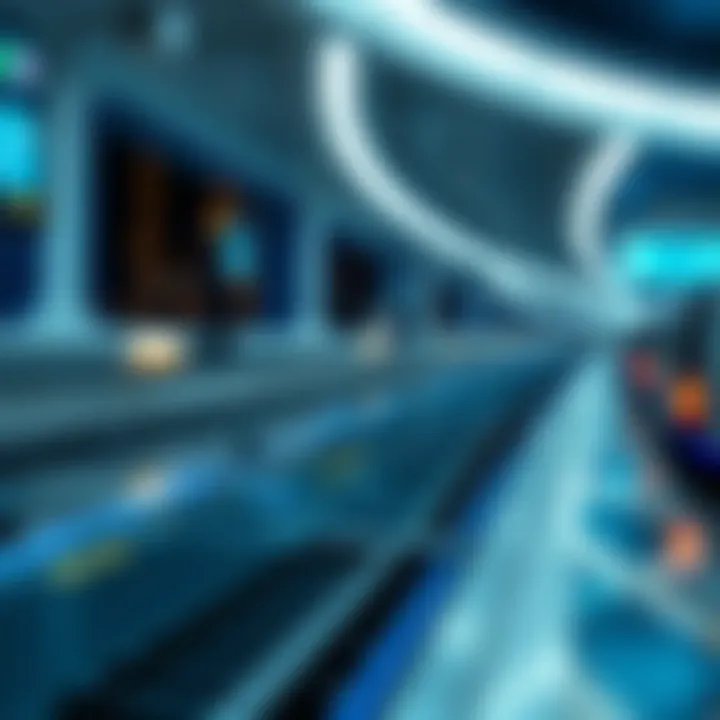
This deep dive into the Blue Line Metro prepares us to explore its architectural, operational, and social implications that will shape Dubai's future transit landscape.
Design and Construction of the Blue Line
The construction of the Dubai Blue Line Metro is a pivotal element in the broader context of urban development and public transportation planning within the city. This section delves into the intricacies of its design and construction, addressing the essential features, benefits, and challenges that come with such an ambitious project. A well-planned metro network not only eases traffic congestion but also enhances the overall quality of life for residents and visitors alike.
Route and Stations
The route of the Blue Line Metro has been meticulously planned to traverse through some of the most densely populated and commercially vibrant areas of Dubai. Stretching across the city, the Blue Line connects key districts, including Downtown Dubai and Dubai Marina, facilitating seamless travel for commuters and tourists.
- Key stations along the route include:
- Sheikh Mohammed Bin Rashid Boulevard: Positioned close to numerous hotels and attractions, this station aims to cater to both residents and visitors.
- Dubai Mall: A crucial point for connecting shoppers and tourists to one of the world's largest shopping destinations.
- Dubai Marina: This station serves the bustling community and enhances accessibility for those living and working in the area.
These stations have been designed with user experience in mind, incorporating facilities for easy transfers, shopping, and dining, ultimately promoting passenger flow.
Technological Innovations in the Metro System
The Blue Line is not only a marvel of engineering but also a showcase of cutting-edge technology. The implementation of smart ticketing systems allows for streamlined, cashless transactions, enabling passengers to travel effortlessly throughout the metro system. Additionally, the use of AI-driven monitoring systems enhances safety and efficiency, ensuring that trains are running at optimum performance. Furthermore, the incorporation of green technologies, including energy-efficient trains and renewable energy sources, reflects Dubai's commitment to sustainable development.
Environmental Considerations
In today's world, environmental stewardship is paramount, and the Blue Line’s construction and operation have taken these considerations seriously. Building the metro involved extensive planning to minimize ecological disruption. For instance, measures were implemented to protect local wildlife and habitats during the construction phase.
- The metro lines also incorporate noise-reduction technologies, aiming to lessen urban noise pollution, which is a frequent side effect of public transport systems.
- The project has adhered to strict environmental regulations, emphasizing a commitment to sustainable growth and responsible urban development.
In summary, the design and construction of the Blue Line is not merely about physical infrastructure. It encompasses a holistic approach to urban mobility, technology integration, and environmental sustainability, ensuring that Dubai remains at the forefront of modern urban challenges.
This comprehensive planning reflects a broader vision for not just a metro system, but for a truly interconnected urban landscape that supports growth while preserving the essence of this vibrant city.
When considering investments, understanding the benefits and implications of the Blue Line Metro can significantly influence strategic decisions in the real estate market and beyond.
Operational Structure of the Blue Line
The operational structure of the Dubai Blue Line is a cornerstone in understanding how the metro system functions daily. It serves not only to connect various parts of the city but also to ensure that the technology and human resources behind the Blue Line work harmoniously. Here, we will delve into the timetables, safety measures, and the management of staff, shedding light on their significance for commuters and stakeholders alike.
Timetables and Frequency
The timetables for the Dubai Blue Line have been designed meticulously to cater to the bustling pace of life in Dubai. Generally speaking, the trains run with impressive frequency, allowing travelers to move swiftly between key locations.
- Peak Hours: During peak hours, trains arrive roughly every 2-3 minutes, accommodating the influx of commuters heading to work.
- Off-Peak: At quieter times, the intervals increase to about 5-7 minutes, ensuring that service remains efficient yet sustainable.
This scheduling flexibility ensures that whether it is a crowded Tuesday morning or a laid-back Saturday afternoon, residents and visitors can rely on swift transportation. The operation of the Blue Line also reflects a balance between demand and operational costs, which is a crucial consideration for Dubai’s economic landscape.
Safety Measures and Protocols
Safety is paramount in any public transportation system, and the Dubai Blue Line Metro is no exception. Robust safety measures and protocols have been put into place to protect passengers and staff alike.
- Regular Inspections: Trains undergo stringent checks, ensuring they meet safety regulations. Maintenance crews are out in force, conducting assessments regularly.
- Emergency Protocols: The staff are equipped to handle emergencies. This includes fire drills, evacuation protocols, and regular training sessions to keep everyone prepared.
- Surveillance Systems: State-of-the-art surveillance provides an added security layer, giving peace of mind to commuters. Emergency buttons are also distributed throughout train cars, ensuring passengers can signal for help if needed.
These measures not only enhance the safety of everyday operations but also foster public trust in the metro system. After all, when people feel safe, they are more likely to utilize public transportation, which is vital for reducing congestion across the city.
Staff Training and Management
The human element is crucial to the operational success of the Blue Line. The management and training of staff play a significant role in delivering an outstanding commuter experience.
- Comprehensive Training Programs: New hires undergo extensive training covering everything from operational procedures to customer service skills. This ensures that staff are well-prepared not only to operate trains but to assist passengers effectively.
- Continuous Development: Ongoing training is provided to keep staff updated on the latest operational procedures and safety protocols.
- Employee Well-Being: Management emphasizes employee welfare, recognizing that satisfied staff tend to provide better services. Initiatives aimed at promoting a positive work environment are constantly evaluated and improved.
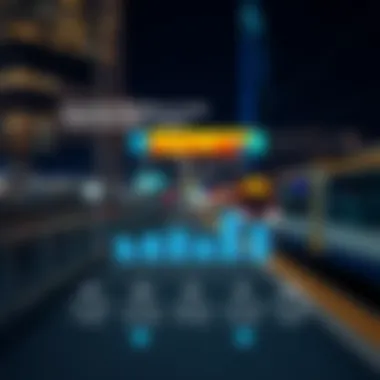

Investors and analysts interested in the Dubai Blue Line can appreciate that well-prepared employees translate into high operational efficiency.
Therefore, the operational structure of the Dubai Blue Line is not just about keeping trains running on time; it’s about creating a reliable and safe travel experience.
The effectiveness of these elements contributes substantially to the overall success of the metro system, making it a pillar of urban transport in a city that commands global attention in many sectors.
Economic Impact of the Blue Line Metro
The introduction of the Dubai Blue Line Metro marks a substantial shift in the economic landscape of the city. As an urban development milestone, this transit system is poised to reshuffle not just the way people move within the metropolis but also the economic factors that influence its growth. The Metro isn't merely a means of transportation; it's an economic engine that fuels development across various sectors.
Influence on Property Values
One clear effect of the Blue Line Metro is its pronounced impact on property values in the vicinity of its stations. Properties located close to metro stations typically experience a spike in desirability due to increased accessibility.
- Urban Infusion: With better connectivity, areas previously seen as less attractive become prime real estate. Take locations near the Al Ghurair Centre or the Dubai Marina as examples. Investing in these areas, post-announcement of the Blue Line, could yield considerable returns due to the anticipated surge in demand.
- Commuter Convenience: For buyers, the prospect of living near a metro station translates to shorter commutes and better work-life balance. Sellers know this, and it can lead to higher asking prices as homes become valuable commodities.
"Investors are keenly aware that property close to reliable public transport is gold dust in any urban center."
Job Creation and Economic Activity
The construction and ongoing operation of the Blue Line are catalysts for job creation. As always, new infrastructure brings a plethora of opportunities:
- Construction Jobs: Initially, thousands of jobs were associated with building the Metro system. From engineers to laborers, the project provided work during its most labor-intensive phases.
- Operational Roles: Once up and running, the Blue Line requires staff for maintenance, security, and operations, adding to the local employment figures. For instance, positions in control rooms or passenger services demand skilled personnel and contribute to steady economic growth.
- Business Opportunities: Increased foot traffic around metro stations often translates to heightened interest from small and medium-sized businesses. Cafés, shops, and service industries can see their fortunes flourish as more customers pass by.
Attracting Investments to Dubai
The Blue Line also opens the floodgates for investments in Dubai. The appeal of improved transportation options makes the location appealing for both local and international investors:
- Global Recognition: As the metro enhances Dubai's appeal as a business hub, international firms are likely to take a closer look. The infrastructural upgrade helps in attracting multinational companies, fostering a climate of innovation and investment.
- Public-Private Partnerships (PPPs): The project further stimulates a model where both government and private sectors collaborate. For example, the private sector can manage facilities or retail spaces, creating opportunities for shared revenue streams.
- Linking Key Areas: The Blue Line links essential business districts with tourism hotspots, enhancing the overall economic activity. A visitor can easily transition from their hotel in the Marina to the financial district without the hassle of traffic jams. This fluidity encourages them to explore and spend.
In summary, the economic impact of the Blue Line Metro extends beyond mere transportation. It reshapes property values, stimulates job creation, and attracts both domestic and international investments, thus weaving itself into the very fabric of Dubai’s economic future.
Social Dynamics and Community Impact
The introduction of the Dubai Blue Line Metro is not just an infrastructural milestone; it marks a significant transformation in social dynamics and community interactions within the city. The Blue Line serves as a bridge connecting diverse communities, enhancing accessibility, and fostering a vibrant urban culture. Understanding these impacts is essential for investors, homebuyers, and urban analysts alike, as they can shape future residential preferences and community planning.
Accessibility for Residents
Accessibility stands at the forefront of the Blue Line's impact. By linking under-served neighborhoods to key areas of employment and recreation, it fundamentally alters residents' everyday lives. Commuting time reduces, commuting costs decrease, and the overall convenience of public transport increases.
Residents in areas farther from the city center can now easily reach business districts and shopping hubs, allowing for more inclusivity in the metro's operations. This enhanced mobility benefits not just individuals; it also encourages local businesses to flourish. Now that residents can affordably travel with ease, shops and eateries in residential zones can tap into a broader customer base. Community members will find themselves engaging in broader social activities, leading to a healthier, more interactive urban environment.
Enhancing Urban Mobility
Urban mobility involves the complex dance of people and transport systems interacting smoothly. The Blue Line promises to enhance this choreography, facilitating better movement across the city's landscape. Unlike traditional transport systems that often get bogged down in traffic congestion, the metro operates on a fixed schedule and predetermined paths. This efficiency ensures fewer delays, making Dubai stand out in terms of public transport reliability.
Investors should take note of how this improvement may influence demand for property close to stations. As access to efficient transport options becomes a priority for homebuyers, proximity to the metro line may command a premium, thus shaping the real estate landscape. More than merely a transport solution, the Blue Line is an architect of urban life, redefining neighborhoods and boosting their value.
Cultural Exchange and Community Building
The cultural fabric of Dubai is rich and diverse, woven from threads of various nationalities, languages, and backgrounds. The Blue Line can play a pivotal role in nurturing this cultural exchange. With multiple stops across city neighborhoods, it encourages interaction among residents from various backgrounds—fostering an environment where cultural encounters become the norm rather than the exception.
Events, art exhibitions, and local fairs can easily attract visitors from different parts of the city using the metro, thereby cultivating a sense of community and belonging. Furthermore, the emergence of vendors and cultural stations within the metro system presents unique opportunities for local artisans and businesses.
"The Blue Line stands as a testament to how transportation can bridge cultural gaps and create vibrant urban communities."
Effective community engagement strategies around the metro can facilitate this exchange, ensuring that diverse voices contribute to the urban tapestry. The continued collaboration between local communities and transport authorities will enhance these benefits and promote social development.
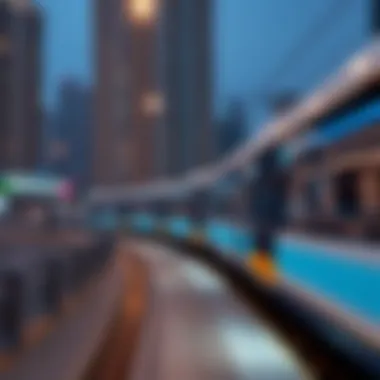
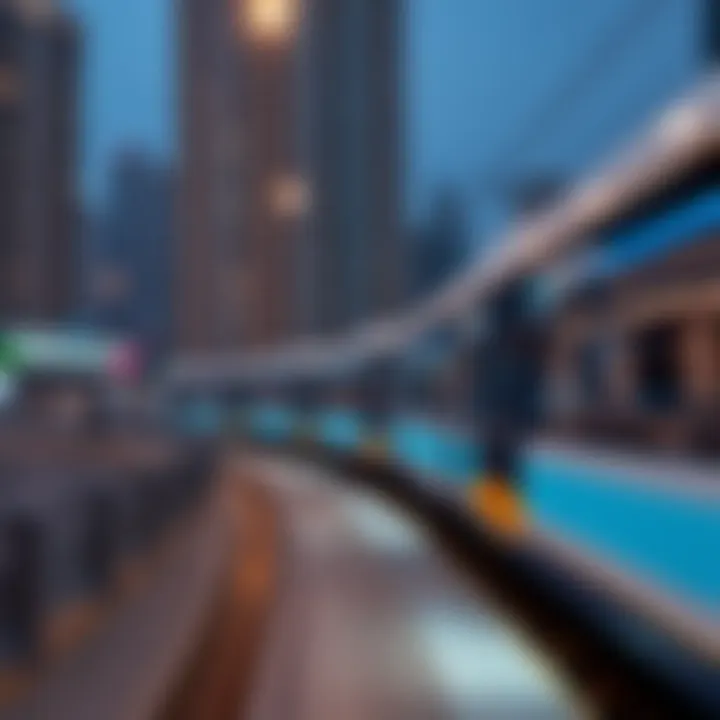
In summary, the social dynamics around the Dubai Blue Line Metro extend far beyond mere transport benefits. From enhanced accessibility for residents to enriching cultural exchanges, its impacts ripple through the fabric of urban life in Dubai. This evolution signals to stakeholders that understanding these nuances is essential for navigating the future real estate and community engagement landscape.
Challenges and Considerations
Challenges and considerations surrounding the Dubai Blue Line Metro hold significant weight in understanding its overall impact and implications. These challenges, ranging from construction delays to the complexities of public anticipation, paint a clear picture of the hurdles faced by such a monumental infrastructure project. Addressing these elements is not just about problem-solving; it's about ensuring that the metro serves its intended purposes effectively, providing a reliable transit option that enhances both urban mobility and economic growth.
Construction Delays and Budget Overruns
One of the most pressing issues in mega-projects like the Dubai Blue Line Metro is the potential for construction delays and budget overruns. This isn’t just a matter of inconvenience; it speaks volumes about planning and execution efficiency. Delays could stem from numerous factors, including unforeseen geological challenges, logistical hiccups, or even regulatory red tape. For instance, if construction were to unearth unexpected soil conditions, it could lead to extensive redesigns and eventual delays in the projected timeline.
When the project costs surpass initial budgets, it not only impacts the funding available for future phases but also raises eyebrows regarding fiscal responsibility. Stakeholders, such as investors and homebuyers, closely monitor these elements as they make decisions about engaging in Dubai’s property landscape.
Lessons from other metro systems worldwide reveal that transparency during construction can alleviate public frustration. The evolution of the project’s progress should be communicated effectively to maintain the confidence of both the community and investors. In the meantime, strategies to reduce financial strain can include reevaluating contracts with construction firms or seeking additional funding avenues, such as public-private partnerships.
Managing Public Expectation
Managing public expectation is another critical aspect of the Blue Line's implementation. The excitement that surrounds the opening of new metro lines generates considerable public interest; however, this enthusiasm can quickly transform into disappointment if expectations are not met. Thus, both the government and project managers must keep the lines of communication open and honest.
The anticipation surrounding the Blue Line brings forth a few key sentiments:
- Convenience: The public expects the metro to enhance daily commuting and reduce traffic congestion. If actual service doesn’t match the promised convenience, trust could erode.
- Connectivity: Residents await easy access to key areas of Dubai. If connections to other transport modes are less than stellar, frustration may bubble over.
- Environmental Impact: Increased scrutiny lies on environmental considerations, with many citizens keen on sustainable development.
Public forums, community workshops, and regular updates can supply residents with the information they crave. When they know what the challenges are, why there are delays, and what solutions are being implemented, trust can be nurtured rather than squandered. The more informed the public is, the smoother the acceptance of the metro system is likely to be.
Future Expansion Plans
Future expansion plans are obviously vital to enhancing the Dubai Blue Line Metro's role in the urban transportation framework. However, formulating effective expansion strategies requires foresight and careful planning. The dynamic nature of urban growth necessitates that the system not only caters to current demand but anticipates future needs over the coming decades.
Key aspects of future expansion may include:
- Extending Route Coverage: New lines or extensions to existing lines should consider burgeoning residential neighborhoods or areas marked for development.
- Incorporating Intermodal Networks: Ensuring the Blue Line connects seamlessly with the wider public transport system can maximize its utility and potentially encourage shifts from private car usage to public transport.
- Technological Advancements: Plans must account for incorporating new technological developments in transport such as autonomous trains or higher capacity trains, keeping the system modern and efficient.
Engaging with urban planners, transportation experts, and the community itself when discussing future expansion helps generate well-rounded strategies. It lays the groundwork for a robust transport infrastructure that keeps pace with Dubai's explosive growth while fostering a culture of sustained development in harmony with residents’ needs.
If effectively addressed, the challenges and considerations will not only optimize the operation of the Dubai Blue Line Metro but also stimulate public confidence and benefit the overarching socio-economic landscape in Dubai.
Culmination and Future Outlook
In wrapping up our exploration of the Dubai Blue Line Metro, it’s essential to pinpoint its significance in the broader context of urban transport infrastructure. This metro line, not merely a transportation project, stands as a vital pillar for enhancing mobility, boosting economic growth, and shaping the urban landscape of Dubai.
Long-Term Benefits of the Blue Line
The long-term benefits of the Blue Line extend far beyond daily commutes. Its influence echoes throughout various sectors:
- Environmental Sustainability: By potentially reducing traffic congestion and emissions, the Metro supports Dubai’s ambitions to create a greener, more sustainable urban environment.
- Economic Stimulation: Increased foot traffic around stations may directly influence local businesses. Shops, cafes, and services will likely see a rise in visitors due to enhanced accessibility.
- Job Creation: Over the long haul, new opportunities could surface, not only in construction but also in sectors related to tourism and services, as the easier movement encourages more visitors to the region.
- Cultural Connectivity: The Blue Line also serves as a medium for cultural exchange, knitting together different neighborhoods and facilitating interactions between local inhabitants and tourists alike.
Each of these benefits underscores how a robust public transport system can serve as a catalyst for holistic growth in a city.
Implications for Dubai’s Real Estate Market
The implications for Dubai's real estate market are nuanced yet profound. Investors, homebuyers, and real estate agents should seriously consider the following factors:
- Property Value Increases: Areas adjacent to the Blue Line stations may experience a surge in property values. Buyers often lean towards locations with accessible public transport, providing a solid return on investment.
- Shift in Demand: As commuting becomes easier, the demand for properties in previously overlooked areas may rise. This shift could lead to a more balanced urban development strategy, diminishing the existing areas' overwhelming demand in central Dubai.
- Potential for Mixed-Use Development: The Blue Line opens opportunities for mixed-use spaces, marrying residential, commercial, and recreational facilities. These thoughtfully integrated spaces can attract diverse demographics, enhancing community interaction.
In summary, as the Blue Line begins its journey, it reshapes not just the transportation landscape but also the fabric of Dubai’s neighborhoods. For investors and stakeholders, staying ahead of these trends—and understanding their implications—becomes critical in navigating the ever-evolving real estate market.
"The future belongs to those who believe in the beauty of their dreams."
The Dubai Blue Line Metro promises a brighter, more connected future for all.
For more insights on urban development and transport infrastructure, consider visiting:
Encyclopedia Britannica
Wikipedia
Public Transport in Dubai
Exploring these sources can provide a richer understanding of the implications and benefits of public transport systems in urban areas.















